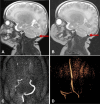Early detection of cerebral sinus venous thrombosis in an extremely low birth weight infant using cranial ultrasound-case report and literature review
- PMID: 39604669
- PMCID: PMC11602796
- DOI: 10.1007/s00381-024-06659-3
Early detection of cerebral sinus venous thrombosis in an extremely low birth weight infant using cranial ultrasound-case report and literature review
Abstract
Introduction: Cerebral sinus venous thrombosis (CSVT) is a serious condition in premature infants. Early diagnosis is crucial, as untreated CSVT can progress to severe complications such as delayed-onset intraventricular hemorrhage (IVH), which could lead to poor outcomes in this population.
Research question: This case highlights that serial cranial ultrasound can detect CSVT early, enabling prompt treatment and preventing subsequent complications.
Methods and materials: We present the case of an extremely low birth weight infant diagnosed with CSVT based on cranial ultrasonography findings. The patient had no clinical symptoms or previously detected brain injury.
Results: Anticoagulant therapy was initiated immediately after diagnosis. Clot resolution was observed on cranial ultrasound after 5 days and confirmed by magnetic resonance imaging (MRI) on the 82 day of life (36 + 4 weeks of gestational age).
Conclusion: This case shows the significant value of cranial ultrasound as a diagnostic tool in premature infants when MRI is not immediately available. Early detection and treatment using ultrasound may help prevent severe complications.
Keywords: Brain injury; Cranial ultrasonography; Extremely low birth weight; Premature infant.
© 2024. The Author(s).
Conflict of interest statement
Declarations. Ethical approval and consent to participate: The patient’s parents gave written informed consent to publish this report, as required by the journal’s patient consent policy. Competing interests: The authors declare no competing interests.
Figures




Similar articles
-
Serial cranial US for detection of cerebral sinovenous thrombosis in preterm infants.Radiology. 2013 Dec;269(3):879-86. doi: 10.1148/radiol.13130401. Epub 2013 Oct 28. Radiology. 2013. PMID: 23985276
-
Grades I-II intraventricular hemorrhage in extremely low birth weight infants: effects on neurodevelopment.J Pediatr. 2006 Aug;149(2):169-73. doi: 10.1016/j.jpeds.2006.04.002. J Pediatr. 2006. PMID: 16887428
-
Magnetic resonance venography to evaluate cerebral sinovenous thrombosis in infants receiving therapeutic hypothermia.Pediatr Res. 2023 Mar;93(4):985-989. doi: 10.1038/s41390-022-02195-5. Epub 2022 Jul 19. Pediatr Res. 2023. PMID: 35854084
-
Multiple thrombosis of the cerebral venous sinuses, neonatal seizures, and minor parenchymal lesions: a case report and a review of the literature.J Matern Fetal Neonatal Med. 2022 Dec;35(25):8507-8510. doi: 10.1080/14767058.2021.1986480. Epub 2022 Feb 9. J Matern Fetal Neonatal Med. 2022. PMID: 35135398 Review.
-
Cerebral Venous Thrombosis: A Comprehensive Review.Eur Neurol. 2020;83(4):369-379. doi: 10.1159/000509802. Epub 2020 Sep 2. Eur Neurol. 2020. PMID: 32877892 Review.
References
-
- Ramenghi LA, Cardiello V, Rossi A (2019) Neonatal cerebral sinovenous thrombosis. Handb Clin Neurol 162:267–280. 10.1016/B978-0-444-64029-1.00012-6 - PubMed
-
- deVeber G, Andrew M, Adams C, Bjornson B, Booth F, Buckley DJ, Camfield CS, David M, Humphreys P, Langevin P, MacDonald EA, Gillett J, Meaney B, Shevell M, Sinclair DB, Yager J, Canadian Pediatric Ischemic Stroke Study Group (2001) Cerebral sinovenous thrombosis in children. N Engl J Med 345(6):417–23. 10.1056/NEJM200108093450604 - PubMed
-
- Berfelo FJ, Kersbergen KJ, van Ommen CH, Govaert P, van Straaten HL, Poll-The BT, van Wezel-Meijler G, Vermeulen RJ, Groenendaal F, de Vries LS, de Haan TR (2010) Neonatal cerebral sinovenous thrombosis from symptom to outcome. Stroke 41(7):1382–1388. 10.1161/STROKEAHA.110.583542 - PubMed
-
- Sorg AL, Von Kries R, Klemme M, Gerstl L, Beyerlein A, Lack N, Felderhoff-Müser U, Dzietko M (2021) Incidence and risk factors of cerebral sinovenous thrombosis in infants. Dev Med Child Neurol 63(6):697–704. 10.1111/dmcn.14816 - PubMed
-
- Rivkin MJ, Inder TE, Volpe JJ (2024) Stroke in the Newborn. In: Volpe’s Neurology of the Newborn, 7th Edition., Elsevier, pp 697–724.e11. 10.1016/B978-0-443-10513-5.00025-5
Publication types
MeSH terms
LinkOut - more resources
Full Text Sources

